Part 2
TERRITORIAL NEBRASKA
Nebraska became a territory in 1854. Her first governor was Frances Burt of Saunders County. Alvin Saunders became the fifth and last governor of the territory. He held office until 1867 when Nebraska became the 37th state of the Union. The county is named for Alvin Saunders.
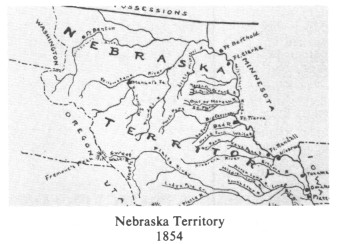 |
| Nebraska Territory 1854 |
page 7
ALVIN SAUNDERS
Alvin Saunders was born on July 12, 1817, in Fleming County, Kentucky; at the age of twelve, young Alvin moved with his family to a homestead near Springfield, Ill. Alvin struck out on his own at the age of nineteen. He finally settled in Mt. Pleasant, Iowa, which at that time was part of the Wisconsin Territory.
The Democratic President, Martin Van Buren, appointed him as the first postmaster of Mt. Pleasant. Later he was removed from his office by President Polk. This caused a rise of indignation which carried the Saunders' name to the attention of the general public. Saunders often said that if it were not for President Polk's removing him from his office, he might not have continued in his political career. His opposition to the expansion of slavery into the territories helped him win a seat in the Iowa Senate.
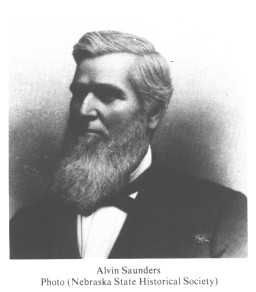 |
Alvin Saunders
Photo (Nebraska State Historical Society) |
In 1860, Saunders was in the Republican ranks, attending Iowa State Republican Convention and the Chicago Convention. In the Chicago convention he became acquainted with Abraham Lincoln, whom he supported vigorously in Chicago and back home in Iowa. Saunders' support was acknowledged in March of 1861, just a few days after President Lincoln's inauguration, when he received his appointment to serve as the Nebraska Territorial Governor.
Two months later came the start of the Civil War. Governor Saunders issued his first proclamation, calling to the counties to organize companies for mustering the 1st Regiment of Nebraska. Later, newly active and hostile Indians made it necessary to form the State Militia. During this time of war, Gov. Saunders continued to show support of the Trans-Continental Railroad, a cause he had long supported.
When the end of his term in office came, he made it clear he did not intend to seek reappointment to the position of Territorial Governor. The Legislature unanimously petitioned President Lincoln to reappoint Gov. Saunders. Shortly before the President left for Ford's Theater where he was fatally shot, he signed the papers, reinstating Alvin Saunders as Territorial Governor of Nebraska. This paper was found on his desk when his office was opened up after his death and the signature is believed to be his last. It is on display at the Nebraska State Historical Society.
In his second term, he began to push for statehood. In 1867, Nebraska became a state. From there, former Territorial Governor Saunders went on to replace Senator P. Hitchcock in the United States Senate. He died Nov. 1, 1899, at the ripe old age of 82. story by Deirdre McNeely
"POLITICAL STRUGGLES FOR NEBRASKA'S STATE CAPITOL"
The third Nebraska Territorial Legislature of Jan. 5, 1857, passed a bill to remove the capital from Omaha to a "paper town" of Douglas, somewhere near the Salt Flats in Lancaster County. Gov. Izard vetoed the bill.
The fourth session of legislature convened Dec. 8, 1857. The issue of removing the Territorial Capital from Omaha aroused legislators to a very bitter and fierce fight. So. Platters were determined to move the capital from Omaha because Omaha was considered to be North of the Platte. There were fist fights on the floor between No. and So. Platte legislators.
The next day the majority of members who were So. Platters met in the town of Florence, six miles north of Omaha. Other members met in Omaha.
Those at Florence voted to move the capital to Neapolis, another paper town on the south bank of the Platte near where Cedar Bluffs is located. This act of the legislature was called the "Florence Secession."
On Jan. 12, 1858, the new Gov. William A. Richardson refused to recognize any decisions or laws passed by the Florence seceders. Thus was killed the vote of the Legislature to locate the capital in what was to become Saunders County. by Elinor L. Brown of Ceresco.
NEAPOLIS
The Nebraska Legislature had many problems to face in 1858, but apparently none as controversial as locating the capitol of the Nebraska Territory.
Neapolis (Greek for New Town), located 2 3/4 miles northeast of present day Cedar Bluffs, was one proposed site, but never got beyond the planning stage and the town faded away. It included a few old log structures and existed in the 1850's and 1860's. It was an important site during the building of the Union Pacific Railroad. Cedar trees were plentiful and used for railroad ties - the logs being taken from the surrounding hills.
The community was mentioned as a site for the capitol during a series of bitter fights over the location of Nebraska's seat of government, which extended over the terms of five territorial governors. Everyone wanted his "home town" for the permanent capital and lobbyists kept the controversy alive and heated. They felt that Omaha would never be the center of population.
A compromise was proposed that if a town already in existence couldn't be agreed upon, then a new town would have to be created. Plans fell through and Omaha remained as the seat of government until 1868, when it moved permanently to Lincoln.
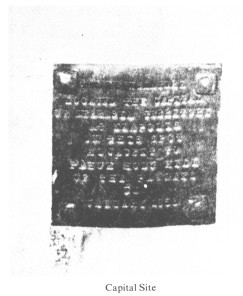 |
| Capital Site |
Boy Scout Troop #104 of Fremont marked the site in 1932 with a simple monument in a ditch by what used to be the Perry Palmer farm. It said, "The Legislature located the Capitol of Nebraska Territory at Neapolis on this spot adjacent to Pahuk Holy Hill of the Pawnee, Jan. 1858." compiled from article appearing in Magazine of the Midlands by Terilee Freeman Roberts
FIRST CEMETERY AT CLEAR CREEK
This so-called Carr Cemetery was deeded by Addison Carr, an early settler and long time resident, to form the first organized white man's cemetery in pioneer Saunders County (then called Calhoun County).
It is located ten miles north of Ashland, west of Highway #63.
By 1957 the cemetery was in a state of great despair. The Ashland Boy Scouts and Explorer Scouts Post #130 deserve much credit for cleaning out brush. A road was surveyed to go through the cemetery. A new fence on the north, east, and south sides was installed, graves were filled in and fifty-one tombstones were cleaned and cemented back in place.
Burt Wells donated a flag pole for Memorial Day, May 30, 1965. This project was organized by Mrs. Harold Wells, a Post Committeeman, and members of the cemetery association. Warren Robinson, Fred Bryant, adult leaders of the Post, organized the work details. Post members worked hard and 640 hours were donated. In appreciation for the service rendered the association presented the Explorer Post with four three-man mountain tents.
When the men were digging for the road, they uncovered nine Indian skeletons. The remains were examined by the Historical Society of Lincoln and came to the conclusion they were pre-historic Indians, long before Nebraska became a state. Since this is on high ground, it indicated it was an Indian Burial Ground.
Some of the stones are faded so that the names can't be read. Dates of 1856 were found on the tombstones.
It is now registered in Book M, page 47, of the Plats and Tracts of Cemeteries of Saunders County, Wahoo County Courthouse.
THE ORGANIZATION AND GOVERNMENT OF SAUNDERS COUNTY
The County was not permanently organized until Oct. 8, 1867; however, important events preceded this. On March 6, 1855, an act was passed defining the boundaries of Lancaster Co. In Jan. 1856, it was proposed to rebound and define the County by surveyed lines and water courses. At that time it was called Calhoun Co. but changed to Saunders on Jan. 8, 1862. This change was made because there was a feeling of political graft concerning the very unpopular name of Calhoun; as many charges of dishonesty were brought in those days.
Other changes and reformations took place Feb. 8, 1865 when the Co. was attached to Cass Co. for judicial, election, and revenue purposes. Two years later it was detached from Cass Co. By Feb. 12, 1866, the boundaries were again changed, attaching more territory from Cass Co. to Saunders.
The first general election was held Oct. 8, 1866; 95 votes were cast. A full slate of officers were chosen and the county seat located at the town of Ashland. At the meeting of Dec. 3, 1866, the County was divided into 3 precincts: Pohocco, Douglas, and Union. By Aug. 24, 1869, the voting precincts of Chapman, Marietta, Wahoo, and Oak Creek were created. Feb. 1, 1871, the precincts of Ashland, Clear Creek, Green, Richland, Rock Creek, Newman, Marble, Center, Mariposa, Elk, Bohemia, Cedar, and Stocking were defined. Later, the southern half of Bohemia became Chester; the northern part of Douglas was made into Morse Bluff. Leshara was the last precinct created, about 1906. Cedar Precinct has been divided into North and South Cedar.
The first filing in the Clerk of the District Court's office was by Sarah J. McClure versus l. Clark and Lewis Clark, June 4, 1867.
The second deed was filed for record at 3 P.M., February 15, 1859. Edgar B. Garrison sold to
page 8
William Garrison of Cass Co., Territory of Nebraska, a tract of land situated in the SW quarter of Sec. 24 in Township 15 N. of Range 7 of 6th Principal Meridian in Calhoun Co., Territory of Nebraska for the sum of $1000.
In 1873, agitation arose to move the county seat to Wahoo. On Oct. 14, an election decided the issue and the capital was moved. In Dec. the records were brought to Wahoo. excerpts from material by Peg Graff
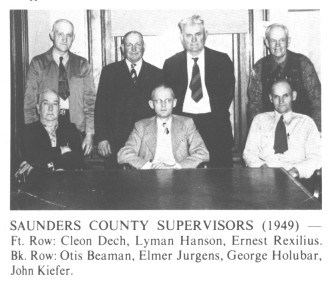 |
SAUNDERS COUNTY SUPERVISORS (1949)
Ft. Row: Cleon Dech, Lyman Hanson, Ernest Rexilius.
Bk. Row: Otis Beaman, Elmer Jurgens, George Holubar, John Kiefer. |
OFFICIALS OF SAUNDERS COUNTY - 1983
Don Clark - Register of Deeds
Betty Patzloff - Assessor
Jim Fauver - Treasurer
Charles Egr - Clerk
Ron Poskochil - Sheriff
Ken Christensen - Superintendent
Fritz Lichtenberg - Veterans Service Officer
Louis Austin - Surveyor
Gladys Pearson - Clerk of the District Court
Betty Zahourek - County Judge
Tom Svoboda - Health Department
Leone Liliedahl - Welfare Director
Loren Lindahl - County Attorney
Archie Hightshoe - 1st Dist. Supervisor, Chairman
Ken Smith - 2nd Dist. Supervisor
Robert Schmer - 3rd Dist. Supervisor
Chester Knuth - 4th Dist. Supervisor
Eugene Kadavy - 5th Dist. Supervisor
Laurel Cook - 6th Dist. Supervisor
Mike Bartek - 7th Dist. Supervisor
Bill Lindholm - County Highway Superintendent
George Rezac - Weed Superintendent
FIRST ELECTION BOOK OCT. 10TH, 1871
SHERIFFS OF SAUNDERS COUNTY
1871 L.B. Reno
1873 L.B. Reno
1875 John W. Moore
1877 Henry Johnson
1879 Henry Johnson
1881 C.E. Lillibridge
1883 O.A. Pierce
1885 John W. O'Kane
1887 D.K. Wilson
1889 John D. Ryan
1891 Joseph Bartek
1893 Joseph Bartek
1895 George Buck
1897 W.D. Farris
1899 T.W. Farris
1901 J.R. Webster
1903 J.R. Webster
1905 Jerry Dailey
1907 Jerry Dailey
1909 Jerry Dailey
1911 Jerry Dailey
1910
1914 Jerry Dailey
1918 Jerry Dailey
1922 Jerry Dailey
1926 L.D. Mengel
1930 L.D. Mengel
1934 L.D. Mengel
1938 L.D. Mengel
1942 Clarence Hagstrom
1946 Clarence Hagstrom
1950 Joe Divis
1954 Joe Divis
1958 Joe Divis
1962 Charles Sayers
1966 Donald Jelinek
1970 Joe Divis
1974 Joe Divis
1978 Ron Poskochil
1982 Ron Poskochil
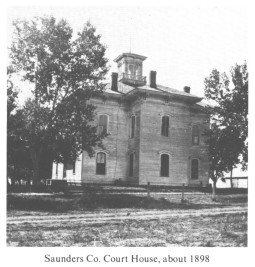 |
| Saunders Co. Court House, about 1898 |
HISTORY OF DEMOCRATIC PARTY IN SAUNDERS COUNTY
Much turbulence and many shenanigans have made headlines in Saunders County politics throughout the years. The Democrats won the first round with the Republicans before Nebraska had even become a state. The County was formed under an act passed in 1856, and being controlled by Democrats, it was named Calhoun County in honor of the famous southern Democrat, John C. Calhoun. But the Republicans were in control by the time of Nebraska's first territorial assembly and they promptly changed the name to that of the new Republican territorial governor, Alvin Saunders.
Then came the boiling issues of the controversy over statehood which mainly arose from the friction between President Andrew Johnson and the group of radical Republicans. There was strong anti-statehood sentiment in the territory, and the manner in which the constitution was drafted and approved by the Legislature further infuriated opponents of statehood. The Democrats in Saunders County went on record as opposing statehood except under certain conditions, including a popular vote on the issue in the territory before any Constitution could be drafted.
However, the territorial Legislature of 1866 did draft a Constitution and submitted it to the people on June 2, that year. It wasn't much of a Constitution and so the battle lines were drawn. It passed by the slim majority of 100 people. Civil war nearly broke out in Nebraska with Saunders County Democrats shouting many cries of "fraud," declaring that the election was stolen. (There is strong evidence that less than ethical tactics were used.) But the hue and cry was to no avail - the Republicans won out and statehood came for the 37th state on March 1, 1867, even though her Constitution was (and still is) a little cloudy.
For some time, prior to statehood, Saunders County politicians and land speculators had been laying imposing plans for the location of the capital of the new state on a high bluff in the northern part of their county. They called it Neapolis. But on June 14 the Capital Commission picked the town of Lancaster, population 30, and further infuriated many of the Saunders County Democrats by changing its name to Lincoln. At least, it was south of the Platte River. A terrible battle had been going on between "South" and "North of the Platters" for the "prized" location of the capital.
Thus, in the new state, the Republicans as the leading party, set down deep roots. They made voting G.O.P. almost a habit; and for a while, Democrats became very scarce. However, a few did make it to the State Legislature. One of these was Alex Boulier of Cedar Bluffs - the first Democrat to go from Saunders County.
Then, hard times and tough going, brought on by drought, high interest and freight rates caused many farmers to lose faith in the G.O.P. By 1894, after a two-year drought, followed by a financial crisis, much land in the county could not be sold at any price. But the names of the strong and hardy Democrats who were to dominate the scene a little later began to be known. In Pohocco Precinct were the Valentine Becks, Robert McCleans, A.M. Maxwells, and Roy and Cy Conrads. Further south were the J.R. Willeys; in Wahoo, the Placeks, the Ludis and Farrises. By 1882, they helped send the first Democrat to state office to serve a term as Treasurer.
By 1894, farmers and townspeople alike were drawn into the Party in Saunders County under the magnetic leadership of W.J. Bryan. Today, in the Wahoo Museum is a Friendship quilt (once a proud possession of the McClean family) made by the Presbyterian Ladies Aid of Wahoo signed by Bryan when he spoke at a 4th of July celebration in Carey's Grove northeast of the present town of Colon. These Democrats started to elect governors and send representatives to Congress, and returned Grover Cleveland to the White House (in 1893). Many a bright block on a prized crazy quilt was formed by the silk badge of a delegate to the State Convention of this year. They also helped send one man from their county to the state legislature who introduced a bill that would not have endeared him to members of either party today. The bill would have made football illegal and provided a maximum $200 fine and imprisonment for violation!
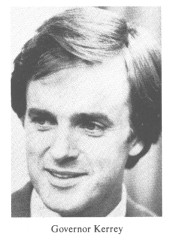 |
| Governor Kerrey |
In 1899, the rains returned to Saunders County and better times came and voters returned to their old voting habits and started electing Republicans again. However, the Democrats, though few in number, were strong and active and kept controversy alive by some hook or crook. For example, it has been recalled by a son of the late John Murphy, a strong Democratic family in the elections in old Sand Creek school north of Wahoo, that fights and arguments were hot and heavy until the election officials of opposing parties mysteriously became very friendly and happy. This usually followed after little visits to the beer cellar of the neighboring Wesely farm.
The first half of the new Century was dominated by the fiery young doctor from Cedar Bluffs who then became County Chairman. Dr. Augustus Stuart led the Party over many rough spots and ruled it with a "heavy" hand. "Old Doc Stuart", as he later became known to everyone in county, helped shape the politics here until his death. Nelson Ludi of Wahoo also served as chairman several times.
page 9
During the 1930's, Hoover's "prosperity", (which didn't quite get around the corner), drove many people back into the party, and Saunders County went Democratic along with the whole nation. Faithful workers in the Party were Emil Placek and Thelma Brown of Wahoo, H.P. Haessler of Leshara, the Holtorfs of Malmo, the Norenbergs of Mead, Matulkas of Valparaiso, Murphys of Sand Creek, Knutzens of Cedar Bluffs, as well as the Medunas and Vasinas, and the Nemecs and Barteks.
When Dr. Stuart died, Ernest Schiefelbein of Wahoo became County Chairman and, upon his death, Fred Norenberg took over until he passed away in 1967.
Then, the reins of the party fell into the hands of a young married couple, George and Marjorie Haessler of Wahoo. Under their fine and vigorous leadership much strength was gained and the county sent Frank Morrison to the Governor's chair three times in the 60's.
In the early 70's, the Party forged ahead under the chairmanship of young Jim Humlicek, a teacher of Neumann High School in Wahoo. He sparked great interest among the young and the young-of-heart. With the help of Mrs. Sid Nelson and Mrs. Edie Haba of Swedeburg, Jim encouraged Saunders County to support and elect Governor Jim Exon. Exon served Nebraska for two full terms. He was an excellent governor and left the state treasury with a large surplus.
Following Mrs. Haba, in 1972, Ervin Matulka of rural Valparaiso became Chairman of the Party and Dorothy Boettner became Vice-chairman in 1976. That year the county helped elect Edward Zorinsky of Omaha the first Democratic Senator from Nebraska for a long time. The women, under Mrs. Boettner's lead, designed and made a County Friendship Quilt that raised over $2,000 to aid candidates.
In 1978, Governor J.J. Exon moved from Governorship to United States Senator giving Nebraska two Democratic Senators. D.O.H. Person became the State Vet and was elected to the State Legislature. Joe Divis became State Fire Marshall.
The first women to be elected delegates to the National Conventions were Dorothy Boettner in 1976; Vera Enyeart in 1980 and Marjorie Haessler, an alternate in 1980.
In 1982, Nebraska elected a Democrat, Robert Kerrey as their new Governor. And for the first time in the Party's history, Nebraska had a Democratic Governor and two Democratic Senators!
REPUBLICAN PARTY
The Republican Party is one of the leading political parties in Saunders County. Nationally, it has been organized since 1854.
Listed here are some of the past County Republican Chairmen: Claude D. Lutton and Charles N. Walton of Ashland; R.C. Johnson of Mead; Ronald C. Romans of Yutan; Robert Hageman of Ithaca; Richard Weaver, Myrl D. Edstrom, Ed Erickson, Jim Campbell and Curtis A. Bromm of Wahoo. The present chairman is George L. Nicodemus of Malmo.
Several individuals have run for the State Legislature and are named as follows: R.C. Johnson, Claude Lutton, Charles Walton, Robert W. Hageman, and recently, Kenneth Smith for Lt. Governor. Alfred Brodahl of Wahoo served in the Legislature following O.H. Person who served several terms. Some of these men also served on the Nebraska Republican Central Committee.
R.C. Johnson was known as Mr. Republican in this county. In the state he was called the biggest Republican in Nebraska. Some of his accomplishments were: served forty years as Sergeant at Arms at State Republican Conventions; served many years as Marietta Precinct Chairman; served on County Central Committee; Chairman of Saunders County Republican Party for two terms; delegate to State Republican Convention many years; served on State Central Committee of the Republican Party; ran for State Legislature twice, and for Railroad Commissioner.
|
Oct. 16, 1980. SAUNDERS CO. REPUBLICAN DINNER
L. to R.: Michael Reagan (Pres. Reagan's son), Don Clark, Robert Hageman and Ken Smith. |
On the national level R.C. was elected as a delegate to the National Republican Convention four times.
In 1948, R.C. attended the Convention in Philadelphia when Dewey was nominated; in 1952 he attended the National Convention in Chicago when Dwight D. Eisenhower was nominated; in 1956 he attended the National Convention held in the Cow Palace in San Francisco when Eisenhower was again nominated; in 1960 he attended the National Convention in Chicago when Richard Nixon was nominated.
R.C. was the Sergeant at Arms for the Nebraska Delegation at the National Republican Convention each time in session.
It is hoped that some of R.C.'s dedication to the Party has rubbed off on many different individuals because there are many worthwhile projects to be accomplished in our Saunders County for the good of the cause and for the benefit of many people.
REPUBLICAN WOMEN'S CLUB
The Saunders County Republican Women's Club was organized September 26, 1958, at the Fairview Cafe, Wahoo, in response to a call from Mrs. Hubert Peters of Yutan, Vice Chairman of Republicans in Saunders County.
Mrs. Grace Hahn, Polk, State Vice Chairman, Mrs. Irvin Anderson, Stromsburg, and Mrs. Wallace Sandall, Polk, met with the women. The two latter women presented a skit about "Republican Women".
The following officers were elected: President, Mrs. Hubert (Neva) Peters, Yutan; Vice President, Mrs. Gus (Amy) Houfek, Malmo; Secretary-Treasurer, Mrs. R.C. (Neola) Johnson, Mead; Reporter, Mrs. Robert (Ebba) Edstrom, Wahoo.
The club was organized for the purpose of increasing the effectiveness of women in the cause of good government through active political participation to foster loyalty to the Republican Party and promote its ideals.
The organization was affiliated with the Nebraska Federation of Republican Women from 1963 through 1974.
Speakers throughout the years were United States Senators and Congressmen, State Officials and Senators and their wives; also candidates for Local, State and National offices, some of whom received campaign contributions from the organization.
The club was under the leadership of the following presidents: Mrs. Hubert (Neva) Peters; Mrs. R.C. (Neola) Johnson; Mrs. Burton (Jane) Johnson, Wahoo; Mrs. Wallace (Ellen) Kruce, Colon, and Miss Flora K. Ewart, Wahoo.
The group was reorganized in 1982. Written by Louise Nelson (Clifford)
REORGANIZED REPUBLICAN WOMEN
The Saunders County Republican Women organized on September 27, 1982, joining the State and National Federation of Republican Women. The Charter Club organized under the direction of Mrs. Shirley Peterson, Atkinson, the Nebraska State Federation of Republican Women President.
Officers elected for the '82-'84 term are: President: Mrs. Ken (Roma) Smith; Vice-President, Mrs. Leland (Sandra) Wade; Secretary: Mrs. Bob (Judy) Iiams; Treasurer: Mrs. Ned (Vera) Swanson.
President Roma Smith was presented the club charter at the Federation of Republican Women State Convention held in Omaha in December, 1982.
Club members at present are: Lorene Treptow, Vera I. Swanson, Gladys Swanson, Vera E. Swanson, Faith Smith, Norma Smith, Phyllis Nelson, Sandra Wade, Dorothy Klink, Donna Hageman, LaVerne Gustafson, Imogene Hageman, Sharon Vermeline, Lee Hageman, Cheryl Clark, Phyllis Schmer, Judy Nygren, Roma Smith, Judy Iiams, June Egr, Eleanor Bromm, Evelyn Knox, Neva Peters, Pauline Witte, Gertrude Anderson, Lurine Little, Joyce Christensen, Rose Farr, Jean Tesinsky, Genevieve Christensen, Delores Lindgren, Gladys Kolb, Laura Lindgren, Edith Hanson, and Odette Daharsh. Submitted by President Roma Smith
SAUNDERS COUNTY FIRE FIGHTERS ASSOCIATION
At a meeting held in Wahoo on December 1, 1927, a County Volunteer Fireman's Association was formed. It was voted that each department pay the Association fifty cents a year for each active member. The president notified members to send in their dues so they could plan for some diversion or amusement at the summer meeting. The first annual meeting was held in Yutan on November 8, 1928, at 7:30 P.M. The Mayor of Yutan, W.N. Miller, gave the welcome, Rev. John Schrader gave the invocation, and Rev. Walter Rundin of Wahoo responded. No other records of this or following meetings are available at the present time.
On June 14, 1960, a meeting was held at the Wahoo Fire Station for the purpose of organizing a County Mutual Aid Association. The Saunders County Fire Fighters Association, as it is known today, was born at that meeting. Ashland, Colon, Ithaca, Malmo, Mead, Prague, Valparaiso, Wahoo, and Yutan voted to form the Association. Later Cedar Bluffs, Ceresco, Morse Bluff, and Weston joined. Valparaiso later dropped its membership because of its distance from most of the towns. Each department pays dues of five dollars annually, and has one vote per department at business meetings.
Monthly meetings were held the first year, but since then quarterly meetings have been held. One-day Fire Schools were held at different locations in the county each year for a while. But, in order to insure better attendance, the one-day schools are now held at the Saunders County Fair Grounds in Wahoo with a class program patterned after the Nebraska State Fire School. This program is very well-attended and is a great success.
This County Fire Fighters Association has created a good working relationship and a spirit of fellowship among the people of the various fire departments in Saunders County. Submitted by Lester Zwiebel
| 





